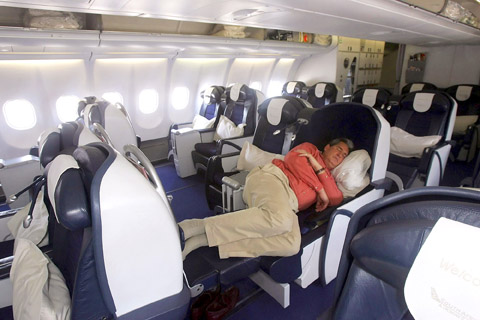If you feel cramped when you fly, imagine the anguish if you were tall.
For extra-tall business travelers, the discomfort continues long after the flight, as their feet dangle off the edge of hotel beds, forcing some to position their bodies diagonally, and as they dance what one tall traveler calls the “shower limbo” thanks to too-low showerheads.
“I truly believe it’s a serious disconnect. I end up literally booking everything myself, travel agents haven’t a clue,” said R.J. Brennan, director of strategic workplace for IA Interior Architects in its Chicago office, who is 203cm tall. “In economy, my knees are embedded into the wire of the seat pocket — I’m literally wedged in and can’t move. On some small planes, I have to physically get off the plane to take my coat off.”

PHOTO: NY TIMES NEWS SERVICE
But some relief is at hand. Two years ago, SeatGuru.com introduced airline comparison charts, allowing readers to see at a glance “seat pitch” — the distance between the back of a seat and the seat in front of it, and the best indicator of legroom — in different classes and aircraft.
One SeatGuru feature allows readers to rearrange the alphabetical airline list by seat pitch, making it obvious that the bigger seat pitches in domestic economy class — 86cm to 91cm — are on United, JetBlue, Delta Air Lines’ McDonnell Douglas MD-88 shuttle, Air Canada and Westjet. Because a seat pitch of only 74cm to 76cm is found in most airlines’ economy class, this is no small potatoes.
Recently, JetBlue reconfigured its planes to sell seats with 97cm of seat pitch in six rows on its A320 fleet and the emergency exit row in its Embraer 190 planes for an extra US$10 or more.
JetBlue’s other seats with up to 91cm of seat pitch in certain rows, have no extra fee.
In Premium Economy, offered by some airlines mostly on international flights, the discount UK airline BMI is the hands-down winner, according to SeatGuru, with 125cm of seat pitch on an Airbus A330-200.
While many tall people say the travel industry seems to ignore them, they are not a tiny market. Five percent of men aged 20 to 74 in the US are 188cm or taller, according to the most recent survey by the Centers for Disease Controls National Center for Health Statistics, conducted from 1999 to 2002.
Thomas Cambier, a 203cm lawyer at Hancock & Estabrook in Syracuse, New York, praised JetBlue for the roomy seats in its economy class. “Those few extra inches make all the difference in the world,” he said.
Brennan said he usually flies United’s Economy Plus, with higher-priced seats that offer up to 13cm more legroom than its economy class, unless he is upgraded to first or business class, and rattled off choice seats like the authority he is.
“Emergency exit row is a subtlety from airline to airline,” he said. “Often the extra leg room is in the row behind it. On a Boeing 737-300, you want the row behind the exit row, in the window seat. On a Boeing 757, a totally different configuration, it’s the exit row window seat.”
But paying a steep price for their height rankles some travelers.
“Special accommodations can be made, but often you pay more to get them,” said Colin Hutt, president of Primum Marketing Communications in Milwaukee, who is 193cm.

One of the biggest sore spots in Taiwan’s historical friendship with the US came in 1979 when US president Jimmy Carter broke off formal diplomatic relations with Taiwan’s Republic of China (ROC) government so that the US could establish relations with the People’s Republic of China (PRC). Taiwan’s derecognition came purely at China’s insistence, and the US took the deal. Retired American diplomat John Tkacik, who for almost decade surrounding that schism, from 1974 to 1982, worked in embassies in Taipei and Beijing and at the Taiwan Desk in Washington DC, recently argued in the Taipei Times that “President Carter’s derecognition

This year will go down in the history books. Taiwan faces enormous turmoil and uncertainty in the coming months. Which political parties are in a good position to handle big changes? All of the main parties are beset with challenges. Taking stock, this column examined the Taiwan People’s Party (TPP) (“Huang Kuo-chang’s choking the life out of the TPP,” May 28, page 12), the Democratic Progressive Party (DPP) (“Challenges amid choppy waters for the DPP,” June 14, page 12) and the Chinese Nationalist Party (KMT) (“KMT struggles to seize opportunities as ‘interesting times’ loom,” June 20, page 11). Times like these can

JUNE 30 to JULY 6 After being routed by the Japanese in the bloody battle of Baguashan (八卦山), Hsu Hsiang (徐驤) and a handful of surviving Hakka fighters sped toward Tainan. There, he would meet with Liu Yung-fu (劉永福), leader of the Black Flag Army who had assumed control of the resisting Republic of Formosa after its president and vice-president fled to China. Hsu, who had been fighting non-stop for over two months from Taoyuan to Changhua, was reportedly injured and exhausted. As the story goes, Liu advised that Hsu take shelter in China to recover and regroup, but Hsu steadfastly

You can tell a lot about a generation from the contents of their cool box: nowadays the barbecue ice bucket is likely to be filled with hard seltzers, non-alcoholic beers and fluorescent BuzzBallz — a particular favorite among Gen Z. Two decades ago, it was WKD, Bacardi Breezers and the odd Smirnoff Ice bobbing in a puddle of melted ice. And while nostalgia may have brought back some alcopops, the new wave of ready-to-drink (RTD) options look and taste noticeably different. It is not just the drinks that have changed, but drinking habits too, driven in part by more health-conscious consumers and